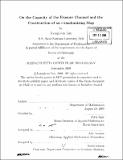On the capacity of the erasure channel and the construction of an [epsilon]-randomizing map
Author(s)
Lim, Joungkeun
DownloadFull printable version (1.820Mb)
Other Contributors
Massachusetts Institute of Technology. Dept. of Mathematics.
Advisor
Peter Shor.
Terms of use
Metadata
Show full item recordAbstract
The quantum information theory is the counterpart of the classical information theory in quantum computation, and it has raised many questions regarding the transmission and security of the information in quantum computers. This thesis studies the efficiency of such processes and contributes to two separate area of quantum information theory. The first half of this thesis presents a communication protocol for the erasure channel assisted by backward classical communication, which achieves a significantly better rate than the best prior result. In addition, we reduce the proof of a new upper bound for the capacity of the channel to a conjecture. The proposed upper bound is smaller than the capacity of the erasure channel when it is assisted by two-way classical communication. Hence, the proof of the separation between quantum capacities assisted by backward classical communication and two-way classical communication is also reduced to the conjecture. The second half of this thesis studies the construction of an c-randomizing map that uses Pauli operators. An e-randomizing map transforms any n-qubit state to an almost random state - a state that is within e-distance of the completely random state, in the trace norm. We show that at least O( Ta ) Pauli operators are required for the construction of an e-randomizing map. This proves the lower bound on the length of a private key required for a private communication as min {2n, n+log23 log(1/c)}+O(1). Our result matches the previous upper bound of n + 21og(1/c) + 0(1) for the optimal key length, in the order of n.
Description
Thesis (Ph. D.)--Massachusetts Institute of Technology, Dept. of Mathematics, 2008. In title on title page, "[epsilon]" appears as lower case Greek letter. Includes bibliographical references (p. 49-50).
Date issued
2008Department
Massachusetts Institute of Technology. Department of MathematicsPublisher
Massachusetts Institute of Technology
Keywords
Mathematics.